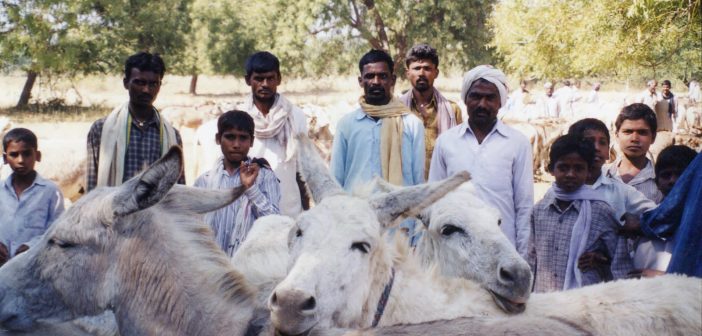(Featured image: people and rescued former working donkeys at Dharma Donkey Sanctuary. Credit Bonny Shah)
“The greatness of a nation and its moral progress can be judged by the way its animals are treated.”
– Mahatma Gandhi
The cases of zoosadism and psychopathic personality disorders causing threat to animals are increasing in India. Among stray animals, dogs suffer the worst from sociopaths who deliberately torture them. Recent incidents in the country point to the exponential growth of psychopathic behavior among people involved in such heinous crimes. An incident last week shows the video of a Chennai based man throwing a stray dog off the terrace of a five storied building. The incident became viral, after which the police identified the man as a medical student. In a similar incident last month, a young engineer stabbed three stray dogs near a metro station in Delhi. These are some of the recently reported crimes, but many domestic and stray animals undergo active and passive torture every day, and most of the crimes go underreported.
In March, a Bengaluru woman was arrested for killing eight puppies, after animal welfare groups raised widespread outrage. In another incident in Tamil Nadu, a group of villagers allegedly killed around 50 dogs in Keezhamur village and burnt the carcasses. At least 50 stray dogs were burned alive a few kilometers away from Chennai last month. These mass killings were done in the name of rabies prevention and security of cattle [1]. There are also cases in which animals undergo sexual exploitation. Most of these cases are not even reported by the witnesses due to the parochial social atmosphere. In Kerala, a dog was allegedly sexually tortured by a man, with the incident coming to light after a video of the act appeared on WhatsApp [2]. Apart from dogs, cattle also face torture and bestiality. In March 2016, a cow was sexually abused by a drunken man in Betul district of Madhya Pradesh. A 50-year-old man was arrested for unnatural sex under the Prevention of Cruelty to Animals Act. Prior to this incident, a man, Kankar Singh Murar, was also arrested for bestiality towards a cow in Balaghat area [3]. Some other similar incidents of zoophilia have also been reported in the state. Accused of bestiality, an 18-year-old boy was brought for medical treatment for his behavior by his parents in South West Delhi [4]. According to the Oct. 2014 report of the NGO Voice of Stray Dogs (VoSD), “the dog rape rate in the country is in the same range as the women’s rape incidence – 20 per 100,000”, which is quite disturbing.
What is even more shocking is that the numbers of educated people and teenagers involved in such crimes are so high. On a close observation, most of the crimes are committed for trivial reasons. In the Chennai incident, the medical student threw the dog from the top of the building merely for fun [5]. The Delhi engineer who graduated from a premier technological institute stabbed three puppies due to love failure and depression. Ponamma, who allegedly killed eight puppies in Bengaluru did that “to teach their mother a lesson” [6]. These incidents indicate that both educated and uneducated people are involved in such crimes, where most of them show psychological problems and behavioral deviations. There is an urgent need for creating awareness among people regarding the reasons and future implications of these deviant behaviors.
Animal Torture and Psychopathic Character Disorder
Active and passive cruelties against animals are very common in India. People generally note active cruelty with deliberate intent to harm an animal by imparting pain and suffering, but willful neglect is the worst face of passive cruelty. Domestic animals, stray animals, hoarded animals, factory animals and entertainment animals face all kinds of cruelties, but most of the people are not aware of the problems that these acts can amount to in the future. Psychologists, Sociologists, Criminologists and animal welfare activists have conducted a wide range of studies which point to the motivations and repercussions of animal abuse.
According to a 1985 study by researchers Kellert and Alan Felthous [7], the major motivations for animal abuse are:
- To enhance one’s own aggressiveness.
- To shock people for amusement.
- To control an animal through inflicting pain, as a result of losing the sense of full control in one’s own life.
- Retaliation against a person by hurting their pet.
- To experience sadism by seeing suffering of the animal.
Frank Ascione, T. Thompson and T. Black also studied the motivation behind animal abuse. According to them, the major motivations behind animal abuse are: Peer pressure, Mood enhancement to relieve boredom, Sexual gratification (bestiality), Forced abuse, Animal phobias and Post-traumatic play [8]. With the development of social media, animal cruelty is propagated through photos and videos of animal torture used in seeking attention. A number of CRUSH videos are uploaded and shared by people these days. Circulated widely, a number of animals die during this heartless entertainment.
Sociologists have found that people who start with torturing animals are more likely to end up as criminals and murderers. “Research in psychology and criminology shows that people who commit acts of cruelty to animals don’t stop there; many of them move on to their fellow humans” [9]. Serial killers and murderers like Ted Bundy, Earl Kenneth Shriner, David Berkowitz, Brenda Spencer and Jeffrey Dahmer are examples of criminals who were previously involved in animal torture. J.M. Macdonald in his 1963 paper, “The Threat to Kill”, proposed the Macdonald triad [10], also known as the triad of sociopathy, which proposed the relation between cruelty to animals and homicidal behavior. Further research in this field by Daniel Hellman and Nathan Blackman [11] claimed substantial evidence for the association of these childhood patterns with later predatory behavior. Researchers have found that some criminals kill animals as a rehearsal for killing human victims. Extensive amounts of humiliation were also found in the childhoods of children who engaged in acts of cruelty to animals. In a study of 45 male prison inmates who were deemed violent offenders, McClellan (2003) found that 56% admitted to having committed acts of violence against animals. It was also found that children who abused animals were more often the victims of parental abuse than children who did not abuse animals [12]. The book The Link Between Animal Abuse and Human Violence (2009), edited by Professor Andrew Linzey (Director of the Oxford Centre for Animal Ethics), gives a deeper insight regarding the problems of animal abuse and its reflection in social life. The increase in number of animal abuse cases is thus the indicator of more deviant characters who may grow up as sociopaths in the future.
Given that a number of studies confirm the relation between animal abuse and psychopathic character disorder, why is the government not able to stop it? The problem here is the obsolete laws which allow people to escape through loopholes. Though Article 51A (g) stands for compassion for all living beings, it is not applicable to all animals in the same manner. When it comes to law, domestic and stray animals are considered in different ways. Under Section 428 of the Indian Penal Code, offences against animals are treated as damage to property or assets, so that a person can face a two-year jail term for killing or maiming a pet animal worth Rs 10 and a five-year jail term if the pet animal is worth Rs 50 or more. However, this law becomes mostly helpless when it comes to stray animals, as they are not considered as property or assets. Generally, Section 429 (mischief by killing or maiming cattle) of the India Penal Code and Section 11 (1) (L) of the Prevention of Cruelty to Animals Act of 1960 (If any one mutilates any animal or kills any animal) serve to benefit pet owners and animal welfare organizations. At the same time, animal sexual abuse is charged under Section 377 (Unnatural Sex) of the Indian Penal Code. That this law is also applied to the LGBTQ community shows that there is no separate legislation to protect animals. These remain major factors behind the increase in frequency of animal abuse. Even if the government adopts strict measures, those who do such cruelty will continue it in the dark, as the animals are helpless. A gradual change can be brought only by creating awareness through education, which can impart in the present generation and posterity a positive attitude towards animal welfare.
The Need for Humane Education
Animal welfare does not appear as a major theme in the general education sector. Neither teachers nor parents take the topic seriously. The current academic syllabi adopted by educational institutions in the country do not give separate space for animal welfare. It is generally considered as a part of environmental studies, which does not give any practical exposure to animal welfare. General education in India should adopt measures to include animal welfare lessons along with training in animal welfare.
A syllabus which includes compassion towards animals and care for the natural world can change attitudes towards animals. Values, responsibility and skills related to animal welfare should be made mandatory parts of the syllabus. As promoted by STRAW (Stray Relief and Animal Welfare) [13], whose motto is “Animal Welfare Through Education,” classes should be “Compassionate Classrooms”, which propagate humane education through school textbooks.
Due to overemphasis on competition-based education, people start forgetting humane elements like sympathy and compassion at a rather early age. At this juncture, Indian education should ACT to inculcate compassion for animals:
Avoid contents that generate hatred towards animals in books and lessons. Avoid visits to places that promote animal cruelty.
Conduct animal welfare programs or visits natural habitats of animals.
Teach empathy and compassion in class rooms; include lessons on the importance of animals and animal welfare in books. Train teachers and provide necessary skills so that they can help students to help suffering animals.
Along with the changes in primary education, higher education institutions should also foster animal welfare. The education sector should join hands with animal welfare organizations and other government bodies to create the desired impact. The program can also be extended to the equivalency educational programs to create awareness among uneducated people.
To ensure sound mental health of individuals and social security, India should adopt humane and value based education system.
References:
- http://timesofindia.indiatimes.com/city/chennai/50-dogs-killed-in-Tamil-Nadu-village/articleshow/52749158.cms
- http://www.dnaindia.com/india/report-dog-raped-by-man-says-animal-rights-body-2179325
- http://www.theindianherald.com/2016/03/middle-aged-man-rapes-cow-in-madhya.html
- http://indiatoday.intoday.in/story/delhi-teen-in-aiims-after-sex-with-calf/1/553035.html
- http://timesofindia.indiatimes.com/city/chennai/FIR-against-Chennai-student-for-throwing-dog-from-terrace/articleshow/53061875.cms
- http://indiatoday.intoday.in/story/bengaluru-woman-thrashes-8-puppies-to-death-to-teach-dog-a-lesson/1/624846.html
- http://cfawr.org/animal-abuse.php
- hhttp://www.petaindia.com/issues/companion-animals/link/
- http://cfawr.org/animal-abuse.php
- http://ajp.psychiatryonline.org/doi/pdf/10.1176/ajp.120.2.125 / http://cfawr.org/animal-abuse.php
- McClellan, J. (2007). Animal cruelty and violent behavior: Is there a connection? Journal of Security Education
- http://www.strawindia.org/







